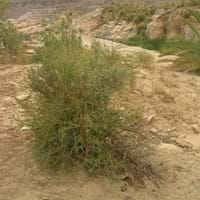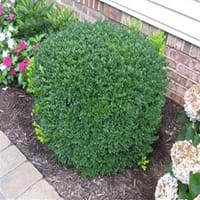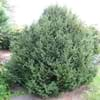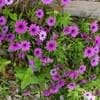Life Span
Perennial
Perennial
Type
Flowering Plants, Shrub
Broadleaf Evergreen
Origin
North Africa
Hybrid origin
Types
Not Available
Not available
Number of Varieties
Not Available
Habitat
Desert, Rocky Mountains
Anthropogenic, meadows, Slopes
USDA Hardiness Zone
Not Available
6-9
AHS Heat Zone
Not Available
Not Available
Sunset Zone
Not Availble
21,22
Habit
Bushy, Evergreen
Oval or Rounded
Flower Color
White
Green, Light Yellow
Flower Color Modifier
Bicolor
Bicolor
Fruit Color
Black, Blue
Not Available
Leaf Color in Spring
Green, Dark Green
Green, Dark Green
Leaf Color in Summer
Dark Green
Dark Green
Leaf Color in Fall
Green, Dark Green
Dark Green
Leaf Color in Winter
Green
Dark Green, Bronze
Leaf Shape
Ovate
Oblong elliptic
Plant Season
Summer
Spring, Summer, Fall, Winter
Sunlight
Full Sun
Full Sun, Partial Sun, Partial shade
Type of Soil
Clay, Loam, Sand
Loam, Sand
The pH of Soil
Acidic, Neutral
Acidic, Neutral
Soil Drainage
Moist but well drained
Well drained
Bloom Time
Late Summer, Summer
Spring
Tolerances
Moisture
Pollution
Where to Plant?
Container, Pot
Container, Ground, Pot
How to Plant?
Seedlings, Semi-hardwood cuttings
Seedlings
Plant Maintenance
Medium
Medium
Watering Requirements
Needs less watering
Keep ground moist, Keep immersed in water, Medium
In Summer
Ample Water
Lots of watering
In Spring
Average Water
Moderate
In Winter
Less Watering
Average Water
Soil pH
Acidic, Neutral
Acidic, Neutral
Soil Type
Clay, Loam, Sand
Loam, Sand
Soil Drainage Capacity
Moist, Well drained
Well drained
Sun Exposure
Full Sun
Full Sun, Partial Sun, Partial shade
Pruning
Prune after flowering, Prune for shortening long shoots, Remove dead or diseased plant parts
Remove damaged leaves, Remove dead branches, Remove dead leaves
Fertilizers
Any balanced general purpose fertilizer
10-10-10
Pests and Diseases
Healthy tree
Blight, Leaf spot, Leafminer, Mites, Psyllids
Plant Tolerance
Moisture
Pollution
Flowers
Yes
Insignificant
Flower Petal Number
Not Available
Not Available
Fragrant Bark/Stem
Yes
No
Foliage Texture
Fine
Fine
Foliage Sheen
Glossy
Glossy
Attracts
Butterflies
Flying insects, Insects
Allergy
Not Available
Itchiness, Skin irritation
Aesthetic Uses
Showy Purposes
Bonsai, Decorating walls, Landscape Designing, Mass in beds, Mixed Border, Showy Purposes, Used for decorating walls, fences, gates, hedges, etc., Used for making hedges
Beauty Benefits
Acne, Good for skin
Not Available
Environmental Uses
Air purification, Food for birds
Air purification, Food for animals, Food for birds
Medicinal Uses
Antibacterial, anti-cancer, Antidiabetic, Heart problems, Kidney problems, Respiratory Disorders, Thyroid problems
Not Available
Part of Plant Used
Flowers, Leaves
Not Available
Other Uses
Used as essential oil, Used in herbal medicines
Used as Ornamental plant, Used for Landscaping
Used As Indoor Plant
No
No
Used As Outdoor Plant
Yes
Yes
Garden Design
Container, Edible, Fruit / Fruit Tree, Shade Trees, Tropical
Container, Edging, Foundation, Hedges, Rock Garden, Wall
Botanical Name
Myrtus nivellei
BUXUS 'Green Velvet' COPF
Common Name
Saharan myrtle
Green velvet boxwood
In Hindi
Saharan myrtle
Green velvet boxwood
In German
Saharan myrtle
Grüner Samt boxwood
In French
myrte subsaharienne
Vert velours buis
In Spanish
mirto subsahariana
boj terciopelo verde
In Greek
Σαχάρας μυρτιά
Πράσινο πυξάρι βελούδο
In Portuguese
murta Saharan
buxo veludo verde
In Polish
mirt Subsaharyjskiej
Green Velvet bukszpan
In Latin
myrto Saharan
Carl viridis praetoriola
Phylum
Magnoliophyta
Tracheophyta
Class
Magnoliopsida
Magnoliopsida
Family
Myrtaceae
Buxaceae
Clade
Angiosperms, Eudicots, Rosids
Angiosperms, Eudicots
Tribe
Not Available
Not Available
Subfamily
Not Available
Not Available
Properties of Saharan Myrtle and Green Velvet Boxwood
Wondering what are the properties of Saharan Myrtle and Green Velvet Boxwood? We provide you with everything About Saharan Myrtle and Green Velvet Boxwood. Saharan Myrtle doesn't have thorns and Green Velvet Boxwood doesn't have thorns. Also Saharan Myrtle does not have fragrant flowers. Saharan Myrtle has allergic reactions like Not Available and Green Velvet Boxwood has allergic reactions like Not Available. Compare all the properties and characteristics of these two plants. Find out which of these plant can be used as indoor plant. If you are interested to decorate your house and garden, find out aesthetic uses, compare them and select the plant which will beautify your surrounding. Along with beautification, try comparing medicinal and edible uses of Saharan Myrtle and Green Velvet Boxwood and you can choose the plant having best and most benefits.
Season and Care of Saharan Myrtle and Green Velvet Boxwood
Season and care of Saharan Myrtle and Green Velvet Boxwood is important to know. While considering everything about Saharan Myrtle and Green Velvet Boxwood Care, growing season is an essential factor. Saharan Myrtle season is Summer and Green Velvet Boxwood season is Summer. The type of soil for Saharan Myrtle is Clay, Loam, Sand and for Green Velvet Boxwood is Loam, Sand while the PH of soil for Saharan Myrtle is Acidic, Neutral and for Green Velvet Boxwood is Acidic, Neutral.
Saharan Myrtle and Green Velvet Boxwood Physical Information
Saharan Myrtle and Green Velvet Boxwood physical information is very important for comparison. Saharan Myrtle height is 200.00 cm and width 200.00 cm whereas Green Velvet Boxwood height is 60.00 cm and width 60.00 cm. The color specification of Saharan Myrtle and Green Velvet Boxwood are as follows:
Saharan Myrtle flower color: White
Saharan Myrtle leaf color: Green and Dark Green
Green Velvet Boxwood flower color: Green and Light Yellow
- Green Velvet Boxwood leaf color: Green and Dark Green
Care of Saharan Myrtle and Green Velvet Boxwood
Care of Saharan Myrtle and Green Velvet Boxwood include pruning, fertilizers, watering etc. Saharan Myrtle pruning is done Prune after flowering, Prune for shortening long shoots and Remove dead or diseased plant parts and Green Velvet Boxwood pruning is done Remove damaged leaves, Remove dead branches and Remove dead leaves. In summer Saharan Myrtle needs Ample Water and in winter, it needs Less Watering. Whereas, in summer Green Velvet Boxwood needs Lots of watering and in winter, it needs Average Water.





